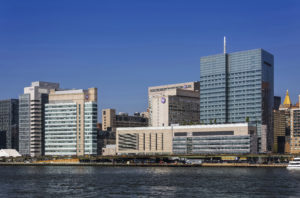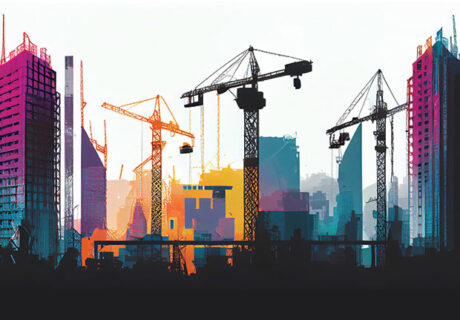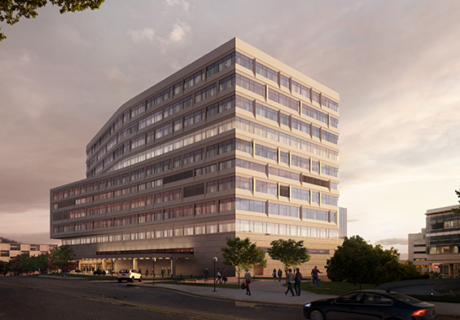Growing Green Rating Systems In Healthcare Design
There are a growing number of third-party environmental rating systems in the healthcare design and construction marketplace, fueled by the increasing interest in health and occupant well-being and the early success of the U.S. Green Building Council’s Leadership in Energy and Environmental Design (LEED) program. But use of these certification systems is relatively limited—why? What are the barriers and challenges? And what might the future development of environmental tools look like and how might utilization by health systems be improved?
To explore these topics and more, a deep-dive workshop was held at the 2019 Healthcare Design Expo & Conference in New Orleans, addressing the question of what’s working for healthcare owners (and what’s not) in today’s green building certification systems. The three-hour event included a discussion on the state of rating systems; a panel presentation by health systems including NYU Langone Medical Center, Kaiser Permanente, and Cleveland Clinic; and breakout discussions among 30 participants representing designers, rating system representatives, and health system facility managers.
Based on the session findings, a survey was developed and distributed to approximately 20 sustainability leaders and engineers at design firms as well as to facility managers. The goal was to develop a snapshot of the current state of healthcare rating and certification systems and identify what the healthcare sector needs from these systems to deliver healthier, restorative, and regenerative buildings that support improving care and reducing operational costs.
Growing landscape
While a number of green building certification systems exist, LEED is the best known and most widely used tool in the market today. LEED for Healthcare (LEED-HC), initially released in 2009 and now in Version 4.1, is specifically tailored to the unique 24/7/365 operational needs of hospital buildings and is the most widely used third-party certification system. Ambulatory projects and medical office buildings use other LEED rating system tools, such as LEED-CI (Commercial Interiors) and LEED-BD&C (Commercial Buildings). A resilience consensus standard called RELi, which Perkins&Will helped to develop in 2012 with the Institute for Market Transformation to Sustainability, is available only to projects seeking LEED certification and offers a comprehensive certification rating system for socially and environmentally resilient design and construction.
The Living Building Challenge (LBC), a product of the International Living Future Institute, provides a framework for performance-based rating and certification of regenerative buildings, such as net positive energy, water, and waste. While it isn’t specific to health facilities, the system is actively seeking pilot projects to recommend adaptations for healthcare projects.
WELL is a performance-based certification promoted by the International WELL Building Institute (IWBI) and quantifies a range of health and well-being impacts on occupants, featuring indicators that include both construction and operational strategies. Fitwel is a health and wellness rating system, managed by the Center for Active Design, with quantifiable indicators that include food, occupant safety, and social equity. Both rating systems are being used by healthcare organization in both new construction and renovation of administrative and ambulatory settings, with Fitwel viewed as an accessible, low-cost option that can be administered directly by building managers. (For more on green building rating and certification systems see sidebar at end of article.)
Barriers to wider adoption
With a growing number of options available, workshop participants and survey respondents identified several perceived barriers to the wider adoption of third-party green building rating systems by the healthcare market.
The cost of the certification process is one of the most commonly cited barriers. This includes not only the certification fees paid to the rating system, which range from 5 to 6 cents per square foot, but also the soft costs incurred by the design and construction teams for energy modeling, commissioning, and certification services (often provided by a third-party consultant). These services have been estimated to add $1 to $5 per square foot (with large projects at the low end and small and/or complex phased projects at the higher).
The price for certification is often viewed as the cost above and beyond that of a building not seeking certification. However, it’s common to optimize performance of new buildings with energy modeling and commissioning—key elements of the LEED rating system—which means these services shouldn’t be included in the cost of certification. Energy modeling is typically used as a code compliance tool, aside from its function as a tool to optimize energy performance, while commissioning is now virtually an industry standard practice, given the level of quality assurance it provides the owner. In other words, the premium associated with certification is often just the cost of a third-party certification consultant and the fees paid to the rating system.
Lack of perceived value of certification is another obstacle, responses showed. Owners, in particular, believe that their project teams are following many of the best practices that are defined within the rating systems and incorporating those ideas, such as local material sourcing and construction waste recycling, into their projects, eliminating the need to incur the cost of certification. In fact, an increasing number of systems are developing construction standards that incorporate many LEED and wellness strategies. However, one of the key attributes of a rating system is to encourage market transformation—changing the way buildings are designed and constructed. In addition, third-party certification explicitly demands rigor: Incorrect products must be sent back to distributors, demolition waste must have a legitimate recycling destination, filters must be changed in the field, monitoring must be documented. These processes require management and time.
The healthcare design and construction industry is heavily regulated, with virtually all aspects of a project subject to at least one code or regulation—everything from room size to ventilation rates to material flame and smoke spread, creating hesitancy to add yet another layer of requirements to projects. However, many health systems now have environmental, social, and governance (ESG) goals, such as energy or carbon emission reductions, which demand documentation that’s inherent in the green building rating systems and certification requirements. In these cases, the rating system becomes an extension of “quality control” and ensures that all projects achieve performance targets that support a system’s ESG goals.
Features of an ideal rating system
Moving beyond the limitations of current systems, participants in the session and survey were asked to name the important characteristics of an ideal third-party rating and certification system. Participants agreed that rating system developers will need to focus on these ideas to grow use by the healthcare sector, particularly in acute care hospital projects. Here are a few ideas for future tools:
- The tool must be healthcare specific. The unique requirements, both regulatory and clinical, of healthcare facilities make it challenging to incorporate generic commercial building rating system strategies. In addition, a healthcare tool should prioritize strategies that make the most difference to the performance of healthcare buildings. For example, the site and location issues (like access to public transit and community services and bike racks and changing rooms) are of little importance to inpatient facilities. On the other hand, health-related issues, such as indoor environmental quality issues (especially access to daylight and views) and flexible design approaches that reduce the environmental impacts of renovations, could have higher emphasis.
- Incorporate ongoing performance reporting and metrics. While there’s value in recognizing a building at the time of its opening, respondents recognized that the highest value of certification is that the facility actually performs to, or above, expectations. This would mean including a requirement for ongoing performance measurement—reward actual instead of predicted performance, much as is done with the EPA Energy Star label. Rating systems should incorporate ongoing tracking of actual performance over time.
- Create synergy with metrics. Rating system metrics should be integrated with metrics for population health improvement as well as staff and patient satisfaction. These metrics are increasingly understood and appreciated by health system leaders and administrators, clinicians, and operators, and tying them in with design and construction certification would greatly improve the rating systems synergies with the organization and increase their perceived value. Including questions on patient and staff surveys that link to sustainability strategies and programs is one way to do this.
- Think system wide. The rating system should work at a building, campus, or portfolio level. Health systems own and operate large building portfolios and often develop robust system-wide construction standards, making individual project certification cumbersome. Rating system certification processes that recognize system standards that align with rating system strategies and streamline individual project certification processes are likely to lessen the cost and complexity of achievement.
A worthwhile process
All green building rating and certification systems share the objective of “market transformation.” The construction industry, and particularly the healthcare industry, is risk-averse. That makes broad adoption challenging. Innovative systems, materials, and construction processes, such as regional materials sourcing, underlie many rating system strategies, and projects pursuing certification tend to be the ones transforming building design. To progress rating systems to the next level and continue this course, it will be critical to recognize the challenges to adoption and visions for what the systems might become.
Kim E Shinn, PE, LEED Fellow, BEMP, is principal and sustainability wizard at TLC Engineering Solutions (Brentwood, Tenn.). He can be reached at kim.shinn@tlc-eng.com. Robin Guenther FAIA, LEED Fellow, EDAC is principal at Perkins&Will (New York). She can be reached at robin.guenther@perkinswill.com.
Authors’ note: The authors wish to thank and acknowledge the contributions of our co-presenters at HCD.19 and their organizations: Steve Guttmann, PE, LEED Fellow – Guttmann & Blaevoet; Jenna Agins and Jocelyn Gan – NYU Langone; Emily Katzin and Jon Utech – Cleveland Clinic; and Don Orndoff – Kaiser Permanente.
Sidebar: Facility Examples
Here are some examples of healthcare organizations utilizing green building rating and certification systems:
NYU Langone: NYU Langone Health’s Manhattan main campus is the first in the world to achieve both USGBC’s LEED Platinum and Performance Excellence in Electricity Renewal (PEER) standards certification. Powered by an 11 megawatt cogeneration plant plus a second 3.3 megawatt cogeneration plant scheduled for operation in the first quarter of 2021, the campus features extensive flood protection infrastructure, enhanced energy management operations, and a 12,000 square-foot green roof. NYU Langone’s comprehensive architectural and engineering design guidelines require LEED Gold or higher for new construction and major renovation projects, as well as consideration of other standards and guidelines, such as WELL and Fitwel for all projects.

Credit: NYU Langone Health/Jeff Goldberg, Esto
Kaiser Permanente: LEED certification is one element of Kaiser Permanente’s multifaceted Environmental Stewardship Program. Another is an ambitious on-site solar power program, including over 45 megawatts of generation deployed at dozens of locations. This program has enabled LEED Gold certifications at locations such as Chino Grand Medical Offices, where solar canopies were integrated into the parking plan under a Power Purchase Agreement in conjunction with the $44M capital project.
Of our 49 LEED certifications, nine are Platinum. San Diego Medical Center is twice certified, achieving a LEED-HC v2009 platinum rating in 2017 and a LEED Building Operations and Maintenance (LEED O+M): Existing Buildings v2009 platinum rating in 2019. Outstanding performance was achieved via water and energy saving innovations that include cooling towers, energy-saving envelope design, active chilled beams, robust performance measurement and verification tools and on-site renewable energy.


Credit: Kaiser Permanente
Cleveland Clinic: Cleveland Clinic is committed to addressing the intrinsic link between an individual’s health and the health of the environment in which they work and heal by designing, constructing, and operating healthy buildings. We strive to incorporate leading-edge products and technologies for lighting, thermal comfort, ergonomics, air quality, water quality and other factors that support the health of caregivers, patients, and communities. To date, Cleveland Clinic has certified 18 building projects to LEED standards, which cover nearly six million square feet or 24 percent of its portfolio. The organization’s green building efforts have enabled it to reduce the energy and carbon intensity of its facilities by 25 percent and 32 percent, respectively, since 2010.
Sidebar: Green Building Rating and Certification Systems
Green Guide for Healthcare (GGHC) was modeled on the original version of LEED for New Construction (LEED-NC) and introduced in 2003. GGHC is a voluntary self-certifying best practices guide. GGHC for design and construction is no longer being maintained, but Health Care Without Harm maintains a guide for operations (https://noharm-global.org/issues/global/green-guide-health-care). It is the foundation for LEED for Healthcare.
LEED for Healthcare (LEED-HC) is the healthcare market sector adaptation of the US Green Building Council’s LEED for Building and Design and Construction’s green building rating system. It is currently the most widely used third party certification system (see LEED by the numbers sidebar). Initially released in 2009, it is currently in Version 4.1, and is specifically tailored to the unique 24/7/365 operational needs of hospital buildings. Ambulatory projects and Medical Office Buildings use other LEED rating system tools, such as LEED-CI (Commercial Interiors/renovations) and LEED-BD&C (Commercial Buildings).
RELi is the most comprehensive certification rating system currently available for socially and environmentally resilient design and construction, available only to projects seeking LEED certification. Though not specifically adapted to hospitals and health facilities, it is particularly suited to define and quantify many resilience strategies that health facilities frequently incorporate (e.g., Hazard Preparedness, Adaptation & Mitigation; Productivity, Health & Diversity; Energy & Water; and Materials & Artifacts). It is currently in version 2.0.
Living Building Challenge (LBC) provides a framework for performance-based rating and certification of regenerative buildings (net positive energy, water and waste). While there is not yet a specific LBC system for health facilities, LBC’s governing organization, the International Living Future Institute, is currently actively seeking pilot projects to recommend adaptations for healthcare projects. A number of sub-certifications within the LBC rating system may be of value to healthcare owners, particularly in the limitations on the use of toxic building materials. LBC is currently in version 4.
WELL is a performance-based certification promulgated by the International WELL Building Institute (IWBI) and quantifies a range of health and well-being impacts on occupants, featuring indicators that include air, water, nourishment, light, mind, movement, materials and thermal comfort. While not specific to health facilities, its emphasis on health and wellbeing makes it easily applicable to health facilities; health systems have used WELL for ambulatory and administrative areas. WELL is currently in version 2.
Fitwel is a health and wellness rating system, managed by the Center for Active Design, developed by the federal Centers for Disease Control and General Services Administration. Developed as a low-cost, easy to use system and certification processes, it includes pathways for both new construction and existing buildings, with specific adaptations to retail, office/workplace and multifamily residential projects, as well as for communities. The quantifiable indicators include food, occupant safety, physical activity and social equity. Fitwel is currently in version 2.1.



